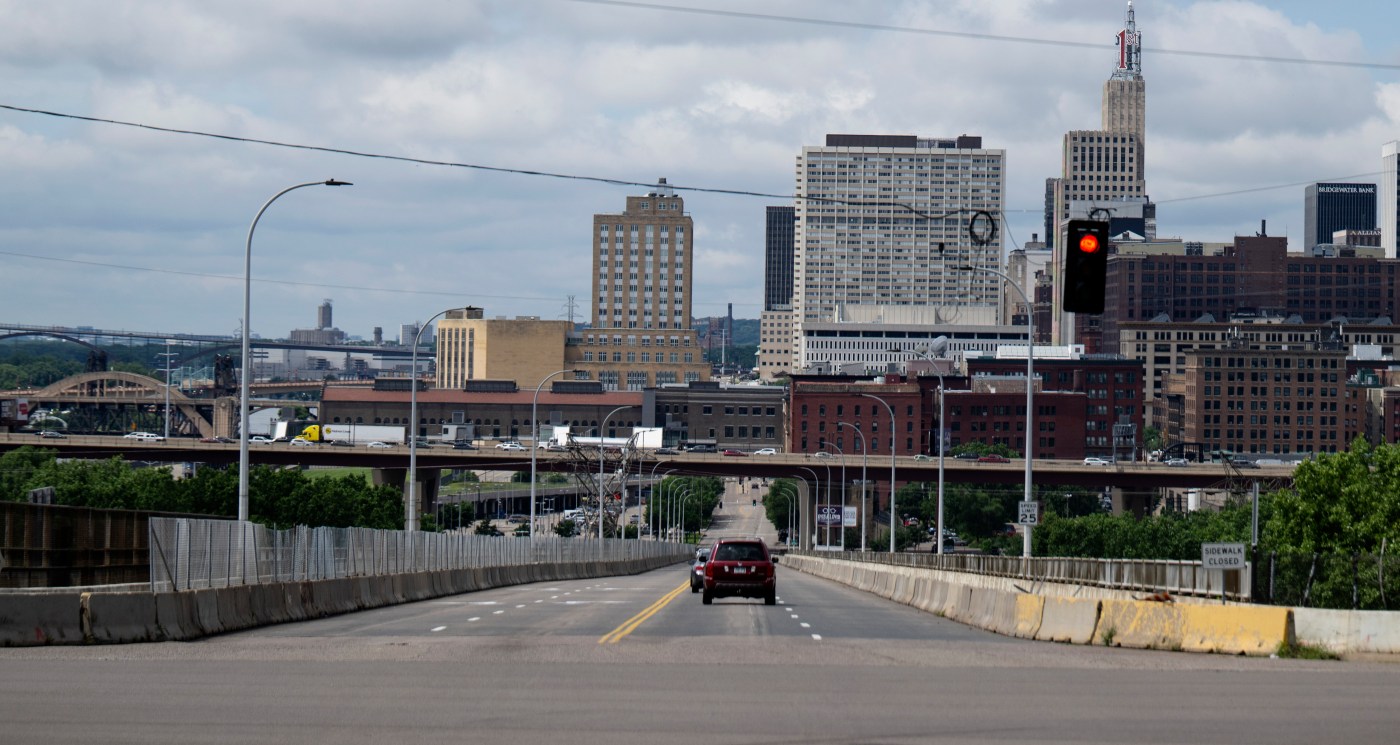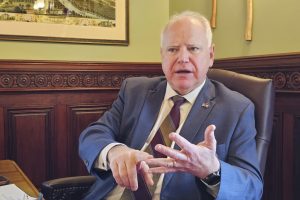
Third Street/Kellogg Bridge will soon close for 3 years as reconstruction gets underway
Beginning around the end of the month, a major reconstruction project will knock the Third Street/Kellogg Bridge offline for three years, closing a key connection between downtown St. Paul and Dayton’s Bluff on the city’s East Side. The bridge will carry its last travelers on July 29.
It’s a project at least a decade in the making, with planning for a new bridge underway since lane and capacity restrictions rolled out in 2014.
The decision was made to limit bridge traffic 10 years ago after city engineers discovered, during pre-design research for repairs, that the bridge was “functionally obsolete” and “structurally deficient” under federal standards, and that its badly cracked cantilevers, or wing-like bridge supports, required costly repair or full replacement.
After years of asking the state to help back construction, the $2.5 billion statewide infrastructure package approved in the waning hours of the 2023 legislative session included $25 million for a new Third Street/Kellogg Bridge, the largest project funded at the time in St. Paul using state surplus or bonding dollars. A new bonding bill did not come together this year.
The final price tag for the new city-owned bridge — $91 million — will include $80 million in state bonds, $7 million in federal funds and $4 million in local funding.
In 2014, replacing the then-32-year-old city-owned bridge had been estimated to cost $30 million to $40 million, compared with $8 million to repair and strengthen the cantilevers. “In those last 10 years, we have also seen industry-wide cost escalations, the result of world conflicts, supply chain disruptions, and impacts from the COVID-19 pandemic and inflation,” said Brent Christensen, assistant city bridge engineer, on Friday.
“It’s really exciting that it’s finally happening,” said St. Paul City Council member Rebecca Noecker, who represents downtown and chairs the city’s Housing and Redevelopment Authority. “It’s been a decade. … I think the best thing we can do is get the work done as quickly and efficiently as we can. It will really be a new and improved Third Street bridge.”
Drivers cross the Third Street/Kellogg Boulevard bridge in St. Paul on Friday, July 5, 2024. (John Autey / Pioneer Press)
‘Long overdue’
Council member Cheniqua Johnson, who represents Dayton’s Bluff, said that while three years of traffic detours will require patience, the alternative to bridge replacement could be even costlier at a later date.
“We need to make proactive repairs rather than reactionary ones,” she said. “I’m willing to wait three years if that means repairing something that is long overdue.”
Public Works staff held a virtual public presentation on June 26, and outreach to impacted properties is underway.
A long road to a new bridge
By early August, bridge work will close Kellogg Boulevard from Broadway Street to Mounds Boulevard. Vehicular traffic will be detoured north to East Seventh Street, though pedestrians and bicycles can use Fourth Street. The downtown St. Paul Union Depot, a transit hub for Amtrak, interstate bus services and the Green Line light-rail corridor, will remain accessible from Lowertown.
Undated courtesy rendering, circa July 2024, of the new Third Street/Kellogg Bridge, which will be constructed over the course of three years beginning around August 2024. The bridge will feature two travel lanes in each direction and a 12-foot-wide bicycle/pedestrian path on each side. It will replace the old bridge, constructed in 1982, which has been deemed structurally deficient and limited to three travel lanes. (Courtesy of City of St. Paul)
The new bridge will have two vehicle lanes in each direction, taller concrete beams and a 12-foot-wide shared-use bike/pedestrian trail on each side, protected by barriers, as well as custom railings with artistic designs. Under the bridge, etchings in the concrete will attempt to evoke the Lakota theme of “Kapemni,” a symbol for intertwining and balance in the universe, according to Public Works officials.
Some public transit advocates had hoped for a dedicated bus lane for Metro Transit’s bus rapid transit services like the Gold Line, which will connect St. Paul to Woodbury when it debuts next year. That won’t be the case.
“I think we achieved BRT goals and needs without providing a dedicated lane,” said Christensen, noting that even at peak periods a dedicated lane would not carry any vehicles on it between 10-minute bus trips. “Over the course of this 2,200 foot bridge, there are no intersections. It’s free flowing. It’s kind of a win-win. The BRT needs are being met and the public also benefits from having a second lane.”
Related Articles
Obituary: Homeless man in Vadnais Heights believed ‘love is bearing one another’s burdens’
Met Council AFSCME workers vote for strike authorization
Forbidden Festival promises eight-hour college music event, open bar, at St. Paul’s Allianz Field in September
A downtown St. Paul church opposes an 88-unit supportive housing facility by Dorothy Day Center
Wadena area priest placed on administrative leave after allegations raised
Demolition to begin this year
Bridge demolition will begin this year, making room for a new foundation and substructure to be installed by the end of 2025. Beams and decks, and then railings and lighting, will be added into 2027, when the new bridge is scheduled to come online by that summer, according to the city.
City engineers had been monitoring the long, linear cracks on the bridge supports with limited concern until they began poking into federal design standards a decade ago, during pre-design work for repairs. That’s when they learned exactly how out of step the structure was with updated standards, which rated the Third Street/Kellogg Bridge “structurally deficient” and “functionally obsolete.”
Cracks found along the bridge’s cantilevers — the support arms extending from the structure’s piers — raised concerns about overloading, inspiring the city to limit traffic in September 2014 to two lanes westbound and one lane eastbound, instead of two lanes in either direction.
A 2014 inspection report by the city noted “extensive cracking at cantilevers” and “longitudinal cracks” at the top of six piers near where the columns meet the cantilevers. Even prior annual inspections had been moved up to about every four months.
Built in 1982
The city-owned bridge was built in 1982 by the Minnesota Department of Transportation and carried about 10,000 cars daily at the time lane restrictions were imposed. Most bridges built in that era have a life expectancy of about 50 years or more.
The bridge design, known as a T-pier, is not uncommon among the state’s 20,000 bridges, according to MnDOT, but state officials have said its cantilevers are somewhat longer than average, making it more susceptible to impacts from heavy loads.
More information about the project can be found online at stpaul.gov/Kellogg-3.
Goodbye Bridge Walk
What: People can take a final walk across the bridge before the deconstruction process begins. The public is welcome to walk on the separated sidewalk area at their own pace and time. St. Paul Public Works will have tables with project information at both ends of the bridge.
When: 1 to 3 p.m. Sunday, July 21
Where: Meet at Eagles Club (287 Maria Ave.) or start at the west end of the bridge at the intersection of Lafayette Street and Kellogg Boulevard.
Related Articles
A downtown St. Paul church opposes an 88-unit supportive housing facility by Dorothy Day Center
St. Paul: Shepard/Warner Road to reopen Wednesday
St. Paul’s Union Depot to host food truck festival this weekend
Amtrak Borealis topped 18,500 passengers between St. Paul and Chicago in first month
Lunds & Byerlys in downtown St. Paul cuts five hours per day


